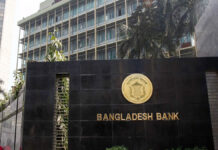The world is changing fast when South Asia is stepping backward. Leaders of the 10-member Association of Southeast Asian Nations (ASEAN) formally signed a land mark declaration of the ASEAN Economic Community (AEC) on November 22.
As per declaration, the new AEC will start formal functioning from this month with the set purpose to create a unified regional block of 600 million people encompassing economic, political, security and socio-cultural integration. They are replicating the model of the European Economic Community which was set up in early 1950s and its subsequent merger into European Union in 50 years time.
Bangladesh’s dilemma
The declaration made no secret that they want to face China and India as two giant political and economic powers on both sides of the ASEAN region. The ASEAN move came from the conviction that unless smaller countries of the region join hands together, they would be totally marginalized in trade and economic growth by both China and India with their heavy weight political influence and aggressive trade expansion.
This was exactly the objectives of the EEC to pull their resources together to achieve higher productivity and market competitiveness in post war Europe facing the Soviet Union in the East and the USA in the West.
There is no doubt the South Asian countries had also set up SARC on initiative by Bangladesh which has now eight members to achieve faster growth but compared with speedy development of the AEC which started integration only recently in 2007, SAARC has remained stagnant without significant progress.
Indian hegemony and its motive to control the smaller nations without sharing resources and the mentality to grow together have so far remained the major road block towards achieving the integration.
What is alarming for Bangladesh is that it has been left out of the US-led Trans-Pacific-Trade Partnership (TPP) agreement of 12 nations which aims at creating a duty free market in the pacific region. Bangladesh’s main rival Vietnam in apparel trade has become a member of that block suggesting Dhaka would face a hard time in global market.
Now Myanmar participation to ASEAN Economic Community will again leave Bangladesh isolated from enjoying duty free market in the region. It shows the country is essentially becoming an Indian market missing every opportunity to join global free trade blocks. The suspension of GSP by the US government has then further degraded the country as not a good place for doing business.
ASEAN Economic Community
Meanwhile, Indian trade blockade on Nepal has created a totally new situation in the region. When the ASEAN nations are extending cooperation towards meaningful integration Indian action on Nepal has simply torpedoed the very idea of effective regional cooperation in South Asia, let alone to speak of securing political and socio-economic integration.
The EEC has meanwhile converted into the European Union (EU) showing the integration of 28 nations into one economic entity and there is every indication that the leaders of the ASEAN countries are moving the region towards that direction.
The signing of the formal declaration took place at a summit in Kuala Lumpur attended by heads of governments of the respective countries. Malaysian Prime Minister Najib Abdur Razzak highlighted the objective of the community saying it will guide the countries to realize a politically cohesive, economically integrated, socially responsible and a truly people-oriented, people-centered rules-based ASEAN region.
US President Barack Obama and UN General Secretary Ban Ki-moon were also present on the occasion.
The idea of an ASEAN economic community (AEC) was initially mooted out in early 2002 and the work towards achieving integration began in 2007. The six major ASEAN countries including Brunei Darussalam, Indonesia, Malaysia, Philippines, Singapore and Thailand went on free flow of goods: by 2010 as duties were eliminated on 99.2 percent of products by then opening borders.
The four others – Cambodia, Lao PDR, Myanmar and Viet Nam – allowed 97.52 percent products at 0-5 percent duty when measures to reduce technical barriers to trade were also implemented to allow free trade within the region to grow.
The AEC has been based on four basic pillars that include (1) Single Market and Production Base to produce and commercialize goods and services anywhere within the ASEAN region; (2) Competitive Economic Region to achieve higher competitiveness of production and capacity for export including free competition inside of its frontiers; (3) Accelerate Economic Development for the benefits of the region through integration of people and businesses; and (4) ASEAN’s integration into the globalized economy working together shunning isolated efforts by individual nation in global market.
Accepts EU principles
The declaration said ASEAN is committed to realize the principles of an Economic Community, inspired by the model of the European Union to allow free flow of goods, free flow of services, free flow of investment, free flow of capital and free flow of skilled labour.
There is no doubt the ASEAN would require some more time beyond 2015 to fully realize the vision of the AEC. Yet it is well advanced on its roadmap to formally realize the working of the community by December 2015 as it has already achieved almost all its targets in the reduction of trade duties.
Only agriculture, steel and auto-making may enjoy some protection at this moment in individual countries.
ASEAN is already working for liberalization and protection of cross-border investments operations, together with best practices for the treatment of foreign investors and investments.
For the free flow of capital, stock exchanges from Indonesia, Malaysia, Philippines, Singapore, Thailand and Viet Nam are working together to form the ASEAN Exchanges to promote regional capital markets and to offer more opportunities to investors.
It is also working to facilitate free flow of skilled labour allowing temporary cross-border movements of people engaged in the trade in goods, services and investment.
The AEC wants to foster a culture of fair competition, which includes protection of consumers and guarantees for intellectual property rights. It also aims at developing highways, airports and rail links, power grids and gas pipelines under joint venture projects.
Source: Weekly Holiday









